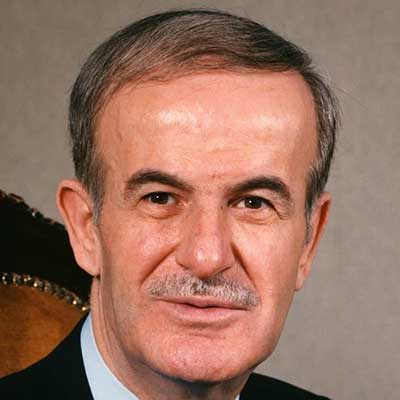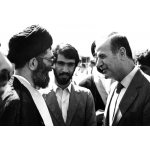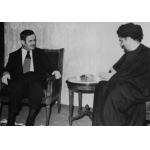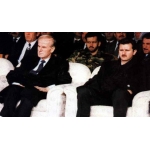Assad, Hafez
Fatemeh Danesh Shakib
308 بازدید
Hafez Assad (1930–2000) was the eighteenth President of Syria who supported the Islamic Republic of Iran during the Iran-Iraq War.
Hafez Assad was born on 6 October 1930 in Latakia. After graduating high school, he joined the Air Force Academy and, upon graduation, joined the Syrian Air Force. From February 1966 to November 1970, he was the Minister of Defense and Commander of the Syrian Air Force. On November 13, 1970, following a coup against the civilian government, Assad became the President of Syria. By April 1971, he was elected Secretary General of the National Command of the Baath Party and assumed the role of Commander-in-Chief of the Syrian Armed Forces.[1]
Before the Islamic Revolution of Iran, the Pahlavi regime viewed Syria's policies as destabilizing to West Asia. Several factors strained relations between Syria and the Pahlavi regime, including border disputes between Iran and Iraq, the regime's recognition of Israel, the dissolution of the Egypt-Syria union, and the rise of the Baath Party in both Syria and Iraq. However, Iran’s financial backing and non-military assistance, in the form of opening a line of credit to the Syrian government, during the 1973 Arab-Israeli War, helped improve relations between the two countries[2]. Nonetheless, Hafez Assad saw the 1975 Algiers Agreement (between Iraq and Iran) as an act of betrayal.[3]
The Camp David Accords between Egypt and Israel, brokered by the United States,[4] led to the recognition of Israel by many Arab countries, resulting in Syria's isolation.[5] Meanwhile, the victory of the Islamic Revolution in Iran in 1979 was welcomed by Assad.[6]
When Iraq attacked Iran in 1980, Syria initially adopted a neutral stance. However, within weeks, the Syrian government began sending weapons and equipment to Iran.[7] In 1980, Hafez Assad met with Yasser Arafat in Damascus.[8] In addition, he tried to persuade Saudi Arabia and Jordan to intervene and bring an end to the war.[9] Iraq captured Khorramshahr on October 26, 1980.[10] This raised concerns for Assad, as Syria had to deal with two enemies i.e. Iraq and Israel.[11] However, as the Iraqi advancement in Khorramshahr stalled[12] and Iran gained the upper hand, Assad was more open in his support for Iran.
In 1982, an agreement between Syria and Iran led to Assad supporting Saddam’s opponents within Iraq, including the Kurds[13]. He also shut off the flow of Iraqi oil through the IPC (trans-Syrian) pipeline to the Mediterranean, thereby reducing Iraq's annual oil revenues by one quarter.[14] Moreover, given that an arms embargo had been imposed on Iran, Assad facilitated the transfer of advanced weapons from the Soviet Union, Libya, and Algeria to Iran.[15] Trying to prevent the formation of a united Arab front against Iran[16] and boycotting the 1982 Arab League summit were among his significant actions to support Iran.[17]
In 1982, as the Iran-Iraq War spilled over into Iraqi territory, Saddam Hussein, who had faced multiple defeats called for peace. Hafez Assad, who had portrayed Iraq as the aggressor, suddenly found himself under scrutiny from the international community and the Arab world.[18] Various Arab states attempted to improve relations between Damascus and Baghdad by offering economic aid to Assad’s government. However, tensions persisted due to Saddam’s bombing of Iranian oil plants in 1985 and Syria’s delayed repayment of its debt to Iran.[19]
Operation Karbala 5 which was conducted on January 9, 1987, coincided with the Islamic Summit Conference in Kuwait, where Assad supported the final resolution calling for an immediate ceasefire between Iraq and Iran. Iran's victory in Operation Karbala 5, which ended on March 26, 1987, prompted Arab leaders to hold an emergency meeting in Amman, Jordan, in an attempt to reconcile Damascus and Baghdad, leading to a meeting between Saddam Hussein and Hafez Assad.[20]
On July 20, 1987, the UN Security Council Resolution 598 was adopted as a result of global diplomatic efforts.[21] Despite its initial refusal,[22] Iran finally accepted the resolution on July 18, 1988, due to Assad's mediation efforts.[23]
After the war, relations between Syria and Iran strained again. However, in late 1990, Assad visited Tehran amidst the Gulf War to strengthen bilateral relations and resolve ongoing disputes. He also attended the 8th Session of the Islamic Summit Conference which was held in Iran in 1997. Subsequently, in early 200, high-ranking Iranian officials also visited Damascus. During the meetings in Damascus and Tehran, both sides discussed issues concerning Turkey, Lebanon, Iraq, Egypt, and Israel. On June 10, 2000, Hafez Assad died of a heart attack.[24]
[1] Sajedi, Ahmad, political celebrities of the 20th century, Tehran: Mihrab Qalam, 1996, pp. 33 and 34.
[2] Soltani-Nejad, Ahmad, Syria's foreign policy in the Iran-Iraq war, Tehran: New Page, 2012, pp. 142 and 143.
[3] Rafiei, Abdullah, Baghdad to Damascus and..., Tehran: Amir Mohammad, 2006, p. 156.
[4] Jazini, Ali, Syria's role in the Middle East peace process: Arab and Israeli compromise, Tehran: Azaryoun publishing house, 1998, p.61.
[5] Shahmoradi, Hossein, The Causes of the Convergence of Iran and Syria, Tehran: Islamic Revolution Document Cente, 2016, p.96.
[6] Soltani-Nejad, Ahmad, Syria's foreign policy in the Iran-Iraq war, pp. 142 and 143.
[7] Emami, Mohammad Ali, Politics and Government in Syria, Tehran: Publications of the Ministry of Foreign Affairs, 1997, pp. 238 and 239.
[8] Shahmoradi, Hossein, The causes of the convergence of Iran and Syria, p. 130.
[9] Imani, Muhammad Ali, Politics and Government in Syria, p. 239.
[10] Ghafouri, Ali, History of Iran's wars from the Medes until today, Tehran: Information, 2009, p. 499.
[11] Saidi, Ebrahim, Discussions of countries and international organizations (Green Book), Tehran: Ministry of Foreign Affairs, 1995, p. 130.
[12] Ghafouri, Ali, History of Iran's wars from the Medes until today, p. 499.
[13] Shahmoradi, Hossein, The causes of the convergence of Iran and Syria, pp. 100 and 101.
[14] Rafii, Abdullah, Baghdad to Damascus and..., p. 161.
[15] Soltani-Nejad, Ahmad, Syria's foreign policy in the Iran-Iraq war, p. 163.
[16] Saidi, Ibrahim, Discussions of countries and international organizations (green book), p. 225.
[17] Saidi, Ibrahim, Discussions of countries and international organizations (green book), p. 225.
[18] Soltani-Nejad, Ahmad, Syria's foreign policy in the Iran-Iraq war, p. 166.
[19] Ibid., p. 172.
[20]Ibid., pp. 180-182.
[21] Hemmati, Iraj, Safaei, Dawood, Iranian Diplomacy and Resolution 598, Tehran: New Page, 2014, p. 211.
[22] Sodagar, Ahmad, 10 resolutions for 8 years of defense, Iran newspaper, special issue on the anniversary of the adoption of resolution 598, July 18, 2010, p. 21.
[23] Soltani-Nejad, Ahmad, Syria foreign policy in the Iran-Iraq war, p. 174.
[24] Shahmoradi, Hossein, The causes of the convergence of Iran and Syria, pp. 104-111.






